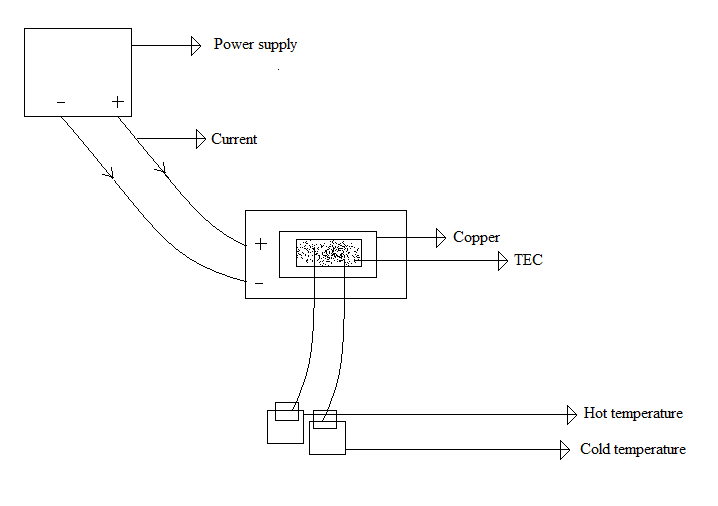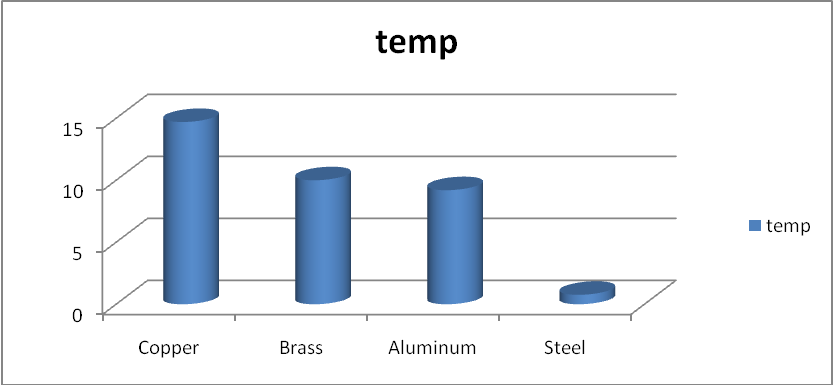Abstract
Thermoelectric gadget is an electric gadget that utilizes electric effect that takes place at the junction where is heat is dissipated away leading to a cooling effect. This experiment is aimed at understating the physic behind thermoelectric cooling, determining the temperature of the system by utilizing thermocouples, establishing the how different variables of a heat sink affects the cooling, insulation effect on the thermoelectric cooler.
Graphs were generated from the data obtained during the experiment. The experiment was carried out under four different experiment conditions where a specific variable was changed and the resulting change tabulated. In the first Experiment , the amount of current was varied and its effect on the temperature by a thermoelectric (TEC). In the second set of experiment, current was kept steady and then the size of heat sink varied to see its effect on the cooling.
In the third Experiment , heat sinks of equal size fabricated from different materials were used under same amount current for different metals. Lastly, using copper heat sink, the first, final, and the thermoelectric cooler at different temperatures were tabulated at the interval of four minutes. At the end of these Experiment s, it was established that the volume or size of heat sink is not directly proportional to the temperature, while the amount of current that flows through the system is directly proportional to the temperature.
Introduction
Thermoelectric coolers (thermoelectric cooler) are devices made from junctions of two semiconductors usually stacked on top of each other. Thermoelectric coolers work by using the Peltier effect to create a heat flux between the two semiconductor junctions, and these semiconductors are made of two different types of materials. Thermoelectric coolers are basically solid state active heat pumped which work by transferring heat from one side to another from the cold side of the device to the hot side. This is against the heat gradient and in the process, electric current is consumed. The electric current that is passed through the junctions makes one side of the junction to absorb energy while the other sides dissipate energy in form of heat. In this way, temperature in those junctions is increased.
The most common uses of thermoelectric coolers are in the cooling of scientific instruments, laboratory equipments and also medical instruments alike. These include computers, medical lasers, refrigerators and constant temperature baths among other instruments. The main advantage offered by thermoelectric coolers is that they are highly reliable, are small and light in weight, they have no moving parts that may require constant lubrication or attention, and their temperature control ranges have an error of ± 0.05 °C. Thermoelectric coolers are the opposite of thermoelectric generators.
In thermoelectric coolers, the Peltier effect is achieved by using current to create a heat gradient between the two groups of semiconductor materials, while in a thermoelectric generator, the Peltier effect is used in that a temperature difference between the two groups of a semiconductor junction is used to generate electric current. Therefore both these devices constructed from the same materials are very closely related in the application of the Peltier effect and are related in the sense that the thermoelectric effect is applied similarly. This experiment seeks to elucidate the mechanism of thermoelectric coolers by using thermal paste, heat sinks and results obtained will be plotted in graphs.
Objectives
- To comprehend the phenomenon of thermoelectric cooling
- To use thermocouples to measure temperature of the system
- To investigate the roles played by heat sinks, thermal paste and insulation in the operation of a thermoelectric cooler.
- To derive and interpret data from graphs
Experiment 1: Effect of current on temperature difference created by a TEC
Equipments
- Heat sink(Copper)
- Thermoelectric coolers gadget
- Sink paste
- Power supplier
- Multimeter
- Temperature adapter
Method
- The thermoelectric cooler assembly was attached to the copper heat sink using a thin coating of heat sink paste.
- The temperatures of both the cold surface of the thermoelectric cooler and the hot surface of the heat sink were measured as a function of current ranging from 0.0-1.0A.
- The thermocouple was covered in heat sink paste first before pressing them to the surface of the heat sink and thermoelectric cooler.
- Time was allowed for the temperatures to reach steady vales after the current was changed. This was about one minute.
Below is the experimental setup that was used to carry out the experiment:

Session 2: Effect of Size of Heat Sink at Constant Current
Equipments
- Different sizes of Aluminium heat sinks.
- Thermoelectric coolers apparatus
- Sink paste
- Power supplier
- Multimeter
- Temperature adapter
- Vernier calliper
- Ruler
Procedure
- The thermoelectric cooler assembly was attached to the various sizes of the aluminium in turn using the heat sink paste.
- Current was then fixed at 1.0 A and passed through the thermoelectric cooler assembly.
- The temperature of the cold surface of the thermoelectric cooler assembly was then measured three minutes after the current had been switched on for all the sizes of the aluminium.
- The heat sink and thermoelectric cooler assembly were at room temperature before the current was switched on.
Experiment 3: Effect of Heat Sink Material
Apparatus
- Four different materials of heat sinks with the same size namely: copper, aluminium steel and brass
- Thermoelectric cooler gadget
- Sink paste
- Power supplier
- Multimeter
- Temperature adapter
Procedure
- Several heat sinks of the same dimensions were used for this experiment. These included aluminium, brass, copper and steel.
- The material which was best for using as a heat sink was established by passing current through them
- The current through the thermoelectric assembly was fixed at 1.0 A.
- The temperature of the cold surface of the thermoelectric assembly was then measured after the current had been switched on for about three minutes.
- It was ensured that the heat sinks and the thermoelectric assembly were at room temperature before the current was switched on.
Experiment 4: System design using thermoelectric coolers
Apparatus
- Different types of heat sinks(Aluminium, Brass, Steel and Copper)
- TEC device
- Thermometer
- Sink paste
- Power supplier
- Multimeter
- Temperature adapter
Procedure
- The experiment was done by initially using a small mass of water (0.051kg) in the small copper container (Ccu =386 J kg-1 K-1).
- The temperature change of the water was measured after 4 minutes. This was also done for the thermoelectric cooler assembly.
- This procedure was repeated for different conditions including a bigger heat sink, the heat sink in ice, a smaller heat sink among others.
- The conditions that gave best results for cooling the water for 30 minutes was selected and the temperature of the water Tw and the temperature of the thermoelectric cooler assembly Ttec was recorded after every 5 minutes.
- The experiment was done at room temperature. From the data obtained, the rate of cooling against time was determined using the equation:
dQ/dt = m*C * (dT/dt)

Results
Experiment 1
Table 1.0: Table showing Effect of current on temperature difference created by a TEC.

Experiment 2
Table 2.0: Effect of size of heat sink on temperature difference.
Experiment 3
Table 3.0: Effect of heat sink material on temperature difference.

Experiment 4
Table 4.0: Effect of different types of heat sink materials on the cooling effect of water.
dQ/dt = M*C* T/ Time, C = 4.184 J/g*k
Data Analysis
- 53.21*(4.184)* (24.2-21.8) / 240 = 2.23
- 53.21*(4.184)* (21.9-21.3) / 240 = 0.557
- 53.21*(4.184)* (21.9-21.3) / 240 = 0.557
- 53.21*(4.184)* (20.4-18.2) / 240 = 2.04
- 53.21*(4.184)* (18.3-10.4) / 240 = 7.33
Discussion and Conclusion
Different factors influence the working efficiency of the thermoelectric coolers. For example, the amount of current that passes through the thermoelectric cooler will determine the amount of heat energy difference created. The higher the current that flows through the TEC, the higher the temperature difference created. The size of the heat sink will also affect the temperature difference of the TEC. The bigger the size of the heat sink, the smaller the temperature difference created. Also affecting the efficiency and effectiveness of the TEC is the type of material used as the heat sink. The cooling effect is decreases when the material used is brass, steel, aluminium and copper in that order.